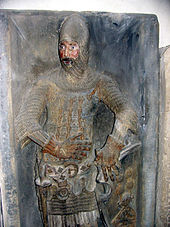Otto VI. (Weimar-Orlamünde)
Otto VI. von Weimar-Orlamünde , also Otto VII (* 1297 , † 1340 ) was a count from the Weimar-Orlamünde family .
Life
Otto VI. was the son of Otto IV von Weimar-Orlamünde and his first wife Adelheid nee von Kevernburg . He was the grandson of the founder Otto III. von Kloster Himmelkron and the last count of the House of Orlamünde on the Plassenburg .
He was married to Kunigunde from the Leuchtenberg family . The marriage remained childless. Nevertheless, the legend wants to see the archetype of the white woman of the Hohenzollern in Kunigunde , who murdered her two children and has to give warnings from the afterlife to repent. But there is no basis for this, since, as I said, the marriage remained childless.
At the time of his death in 1340 Otto had received a loan of 4000 pounds Heller from the Nuremberg burgrave Johann auf die Plassenburg. According to a hereditary brotherhood between Otto and Johann agreed in 1337 , since the marriage had remained childless, the widow Kunigunde was paid 3,000 pounds sterling, with the Plassenburg becoming the property of the Nuremberg resident. Podika von Schaumberg, adopted by Otto and Kunigunde as a child, was endowed by Johann with 1500 shock groschen when Johann married the knight Poske Schweritz in 1341.
Kunigunde bought Heller Castle and the village of Gründlach from Johann and Albrecht the Beautiful for £ 5,000 and built the Himmelthron Monastery there . The remaining income from the inheritance was given to the monastery, which she later entered and where she died as its abbess. Your epitaph is preserved there.
epitaph
The epitaph of Otto VI. is located in the collegiate church of the Himmelkron monastery. The central motif is the count in contemporary armor: he wears chain mail , tunic and greaves and is supported by a tartsch shield . The epitaph is ascribed to the so-called Wolfskeelmeister .
literature
- Ernst Kießkalt: The sculptures of the former Cistercian convent Himmelkron . Bayreuth 1909. p. 5f.
- Gotthilf Friedemann Löber: De burggraviis Orlamundanis . Jena 1741, digitized
- Helmuth Meißner: Collegiate Church, former monastery and Himmelkron Castle . Munich / Berlin 1998.
- Julius von Minutoli: The White Woman. Historical examination of the legend and observation of this phenomenon from 1486 to the most recent times . Duncker, Berlin 1850
- Karl Heinrich Friedrich Chlodwig von Reitzenstein: Regesta of the counts of Orlamuende from Babenberger and Ascanischen tribe. With family tables, seal images, monuments and coats of arms . Bayreuth 1871
- Theodor Zinck: Himmelkron - Description of his past and present . Bayreuth 1925. p. IV. And p. 4.
| predecessor | Office | successor |
|---|---|---|
| Otto IV. |
Count of Weimar-Orlamünde 1305–1340 |
Friedrich I. |
| personal data | |
|---|---|
| SURNAME | Otto VI. |
| ALTERNATIVE NAMES | Otto VII. |
| BRIEF DESCRIPTION | Count from the Weimar-Orlamünde family |
| DATE OF BIRTH | 1297 |
| DATE OF DEATH | 1340 |

